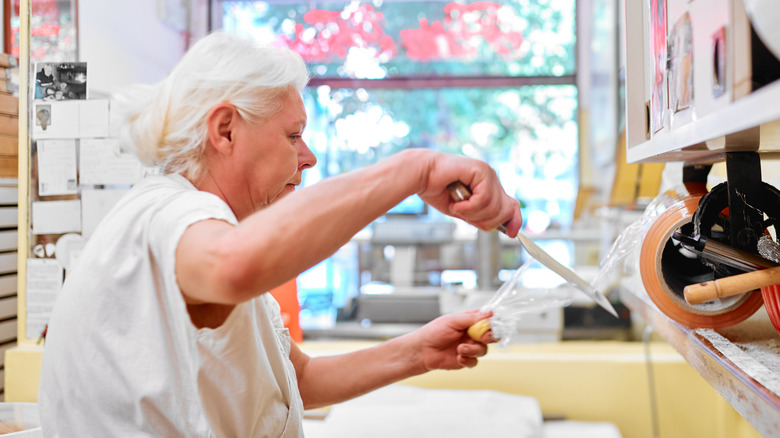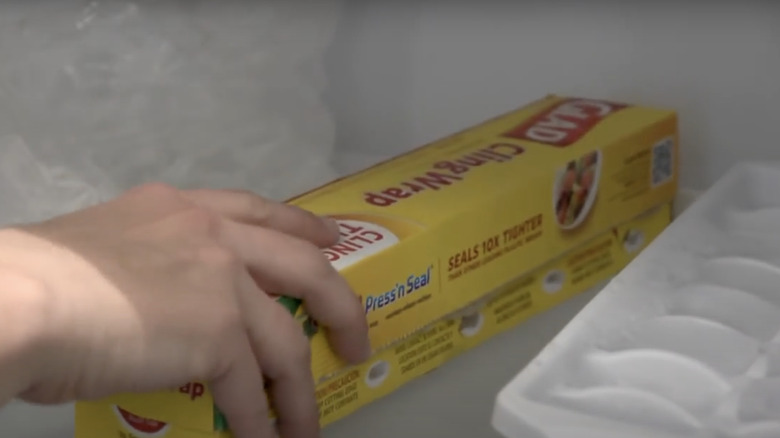Store Plastic Wrap In This Unexpected Spot For Easy Tearing
Plastic wrap is one of the most used packing supplies folks have around their house, especially in the kitchen. It's ideal for chilling cookie dough when you're in a baking mood to wrapping furniture when you're moving. While plastic wrap is handy for food storage, rolling out a plastic wrap from its package isn't always the easiest. The wrap folds and sticks to itself, making it difficult to peel apart and use it. However, storing your plastic wrap in the freezer makes tearing sections effortless. You won't end up with sticky plastic balls when trying to cover your leftovers from dinner.
Most of us store plastic wrap in a random drawer with parchment paper and aluminum foil. Even though there isn't a right or wrong way to store different food wrapping systems, there are ways to store them that will make using them painless. The great thing about putting your plastic wrap in the freezer is you don't have to keep it in there all the time, mainly if you have limited space. However, the longer it's in the freezer, the better it'll work, so you might have to reorganize your freezer to make room for your plastic wrap.
Cold air in freezer reduces static
Using the freezer as plastic storage is an odd way to store it, but it works efficiently, thanks to science. Plastic wrap is made of polyethylene, composed of tight and sticky molecules often used in plastic. The sticky molecules create the static you see when rolling out plastic wrap or trying to open a plastic grocery bag. When you freeze the plastic wrap, the molecules get chilled, making them less sticky. The cool air freezes the static electricity, but when you're ready to use it, the plastic wrap will warm up once it's at room temperature, so it sticks to any container.
Since plastic polyethylene already has sticky molecules, plastic manufacturers add extra adhesives that make them stick to other things. So, when placed in the freezer, the cold reduces the static, allowing them to work better since they're not as sticky. Dr. Chad Orzel, Associate Professor of Physics and Astronomy at Union Collge, claims, "The adhesion between pieces of plastic may be driven by the molecules in the surface re-arranging themselves to form weak chemical bonds. And the lower temperature may inhibit that process a bit" via TODAY Food. You won't have to worry about dealing with sticky static once you place your plastic wrap in the freezer.
Ways to store plastic wrap in the freezer
If you don't want to leave your plastic wrap in the freezer permanently, ensure you leave it in there before you want to use it. The longer it stays in the freezer, the easier it'll be to use, so place it inside for at least 15 to 20 minutes before wrapping anything. Although, if you want to save some drawer space and leave your plastic wrap in the freezer at all hours of the day, find a vacant shelf to put it on so that it isn't pushed to the back of the freezer or crushed under boxes. An ideal place would be in a pocket inside the freezer's door; that way, you can quickly grab it to wrap what's needed.
Get creative with your plastic wrap placement and figure out what works best for you. If you're a savvy DIYer, try attaching the plastic wrap box to one of the shelves so that it doesn't slide off when you roll out the wrap. Cut out a few holes through the box's bottom and loop a few loose zip ties to tie the box to one of the shelving racks. Once you're out of the plastic wrap, easily cut the zip ties and do the same with a new roll. Finding a way to prevent having to remove and put back the plastic wrap will keep it cold and save you a few extra seconds when you're putting away leftovers.

